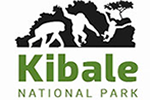Guide to Kibale National Park, Uganda
A Complete guide to Kibale National Park, the best place to see primates in Africa. This website contains every information you need to know to plan your trip to the Kibale Forest National Park in Western Uganda. On this guide find information about the park, the best things to see, things to do, inspiring itineraries and the essential information to help you get the best out of your holiday to the park. Find information about wildlife including monkeys and chimpanzees, birds and more. Listed also are the best activities and experiences to undertake in the park including chimpanzee tracking, chimpanzee habituation, nature walks, guided forest walks etc. We have also listed the best places to stay in Kibale Forest. There is also a photo gallery with photos of Kibale Forest, a forum and a detailed map of Kibale Forest, with all the places of interest near the park. This guide also contains a mammal list and bird list of Kibale Forest.
Kibale Forest National Park
With lush tropical rainforest and a fascinating diversity of animals, Kibale National Park is one of the most beautiful and stunning forests in Uganda. The 766 km Kibale Frest is one of Uganda’s enchanting forested parks. Here, you can hike in the park for hours observing the drama of life in a rainforest. The park contains pristine lowland tropical rain forest, montane forest, and mixed tropical deciduous forest. In addition to forest, you will also notice areas of grassland and of swamp.
The park adjoins with Queen Elizabeth National Park and is an important eco-tourism destination, popular for its population of habituated chimpanzees and 12 other species of primate. Kibale Forest National Park consists of a variety of ecosystems, including forest, grasslands, regenerating forest after logging, agriculture, or plantation use, rivers, lakes, and papyrus swamps.
This park illustrates the future of many forests of Africa, Asia, and South-Central America. It is an isolated forest island surrounded by humanized landscapes that range from small landholder agricultural plots to tea estates.
The park is famed for its habituated chimpanzees and it hosts the highest density of primates in Africa! The park was gazetted as a national park in October 1993 and it is among the best national parks in Uganda.
Kibale Forest National Park, together with the nearby Ndali-Kasende Crater Lakes, are close to being an independent traveller’s dream, blessed with the tantalizing combination of inexpensive accommodation, easy access, wonderful scenery and a remarkable variety of activities. The park is highly alluring to nature lovers for the opportunity to view a wide range of forest birds and track chimpanzees (as well as viewing a wide range of other primates).
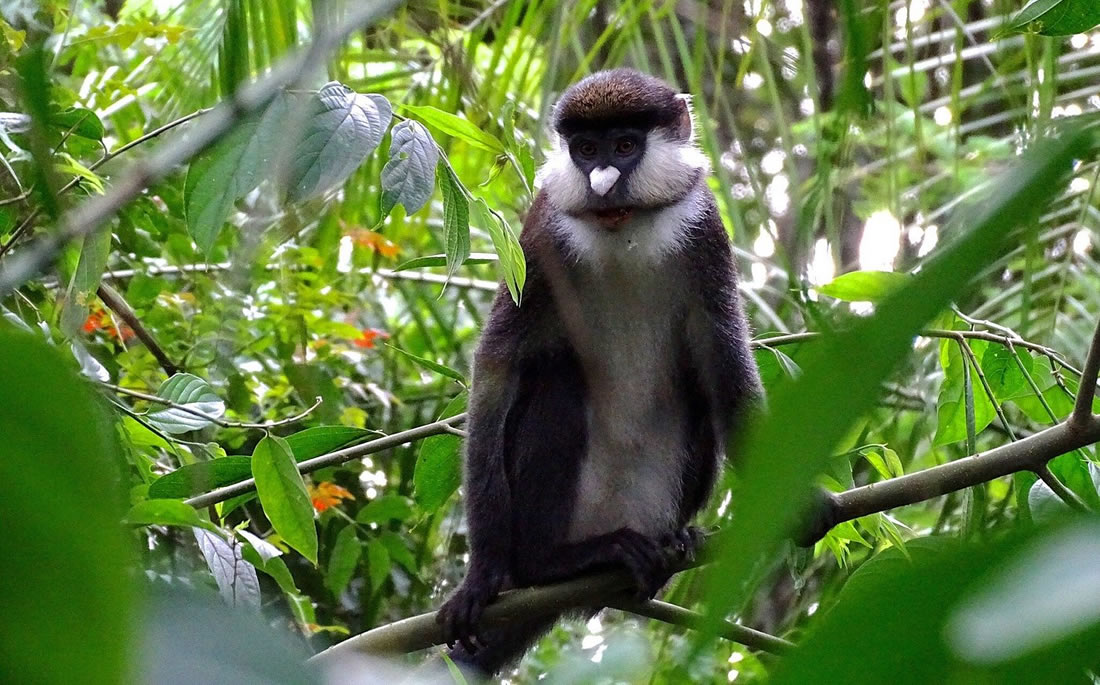
Though Kibale national park is famously known for chimpanzees, the park is home to a total of 70 mammal species. The park hosts 13 different species of primates that are both diurnal and nocturnal. The park also contains over 375 species of birds and it is among the best parks for bird watching in East Africa. The Kibale adjoins Queen Elizabeth National Park to the south to create a 180km-long corridor for wildlife between Ishasha Sector, the remote southern part of Queen Elizabeth Game Park, and Sebitoli in the north of Kibale Forest.
Things to See in Kibale National Park
With lush tropical rain forest and a fascinating diversity of animals, Kibale National Park is one of the most beautiful and stunning forests in Uganda, with the highest diversity and density of primates in Africa.
Wildlife in Kibale Forest
The park has 60 mammal species of which 13 species are primates.
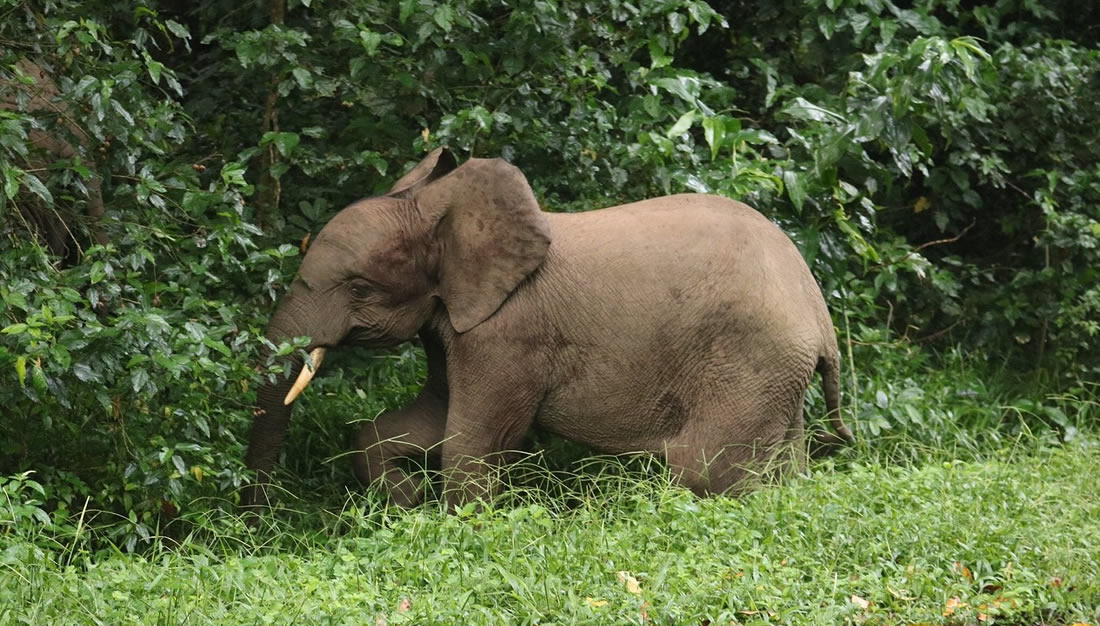
The forest is rich in wildlife.
Primates
This park has the highest concentration of primates in Uganda. The 9 diurnal primates include: vervet, red tailed, L’hoests and blue monkeys, olive baboon and chimpanzee.
Other primates are diademed monkey, white cheeked mangabey, chimpanzees, black, white, and red colobus.
Mammals
The common mammal checklist in the park include: lion, leopard, buffalo, hippo, warthog, elephant, giant forest hog, bush pig, bush buck, sitatunga and Peter’s red and blue duikers.
Some of the other mammals you might see are bushbuck, Harvey’s red duiker, blue duiker, Uganda kob, genet, bush pig, and African civet. More difficult to spot are buffalo, waterbuck, hippo, warthog, and giant forest hog. Herds of elephant once travelled back and forth through the area. These elephants have become more and more rare, and now are seldom seen.
Birds
The bird life in the forests and grasslands of the forest is abundant. Bird species within Kibale Forest National Park number up to 335 species of which four are endemics to Kibale: Cassin’s spine tail, blue headed bee eater, masked apalis and Nahan’s francolin.
Other popular sightings include hoopoe, grey parrot, ant thrush, Negro finch and one particularly worth noting is the Kibale forest thrush, which is endemic to Kibale forest. A four hour bird trail has been laid out for serious birders in the Bigodi wetland.
Butterflies
There are 144 species of butterfly in the park and a diverse population of moths and other insects.
A system of trails has been developed within the park, and tour guides are available to guide visitors.
Chimpanzees
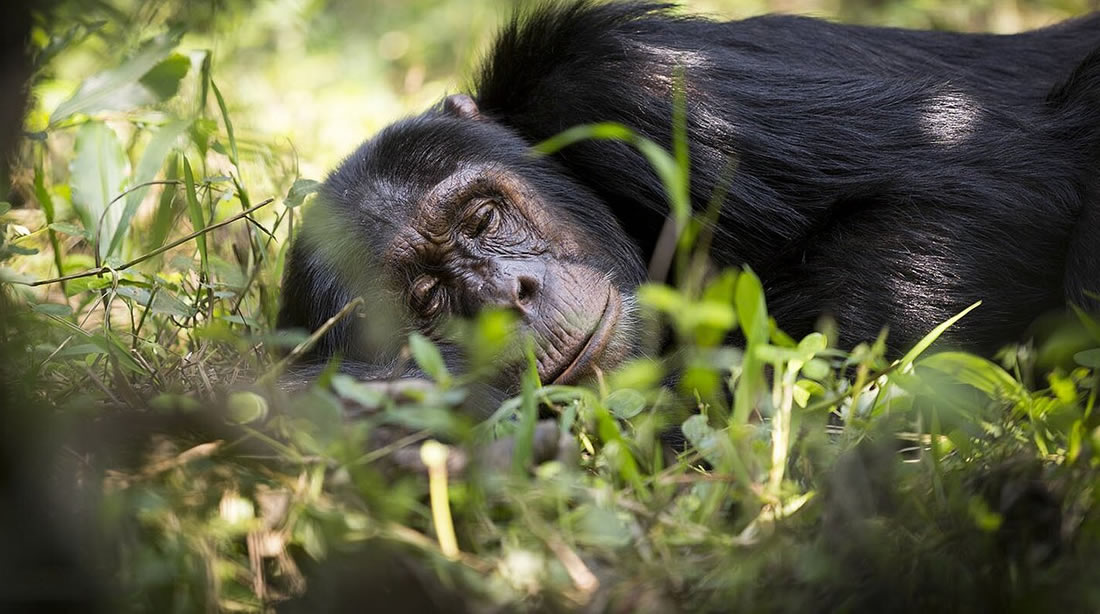 The most famous inhabitants of Kibale National Park are the chimpanzees with over 1,450 individuals protected within the park. At Kanyanchu, a community of chimpanzees has been habituated since 1991, allowing visitors the unique opportunity to view these great apes in the natural environment (with more than a 90% chance of viewing).
The most famous inhabitants of Kibale National Park are the chimpanzees with over 1,450 individuals protected within the park. At Kanyanchu, a community of chimpanzees has been habituated since 1991, allowing visitors the unique opportunity to view these great apes in the natural environment (with more than a 90% chance of viewing).
Birds
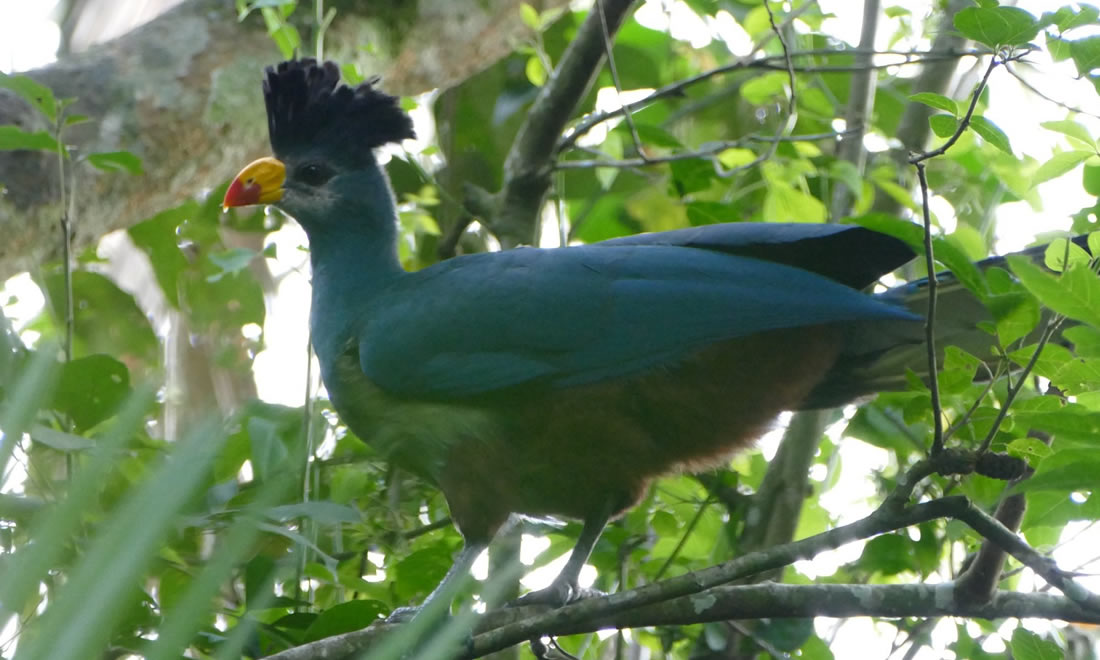 The park also hosts over 325 species of birds including the yellow spotted nicator, yellow rumped tinkerbirds, little greenbul, green breasted pitta, the African pitta, the crowned eagle, the black bee- eater, hornbills and African Grey Parrots.
The park also hosts over 325 species of birds including the yellow spotted nicator, yellow rumped tinkerbirds, little greenbul, green breasted pitta, the African pitta, the crowned eagle, the black bee- eater, hornbills and African Grey Parrots. Primates
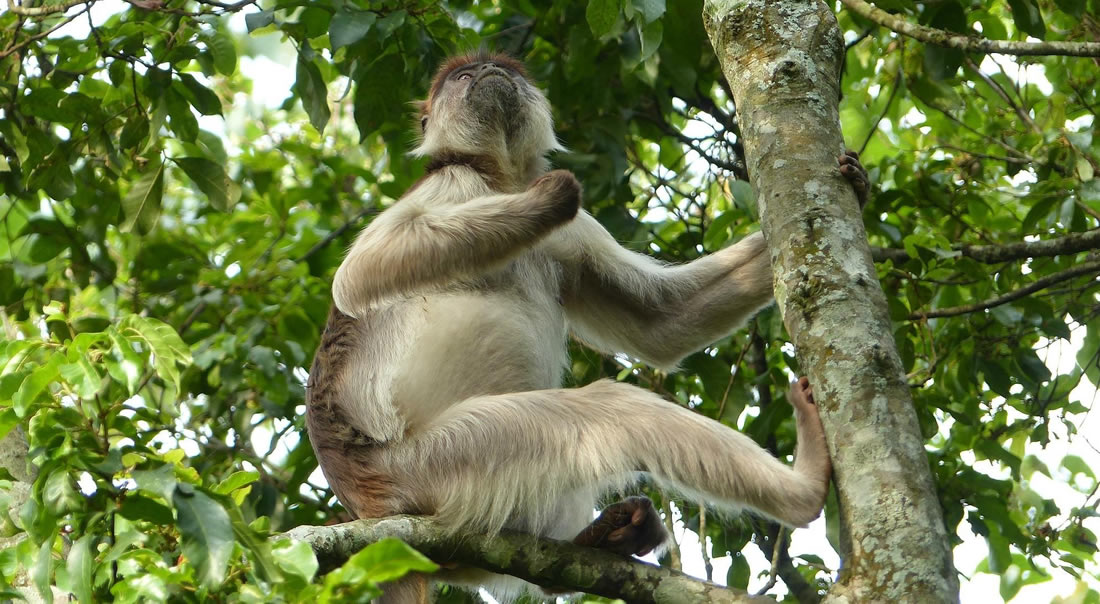 Kibale forest national park is home to a remarkable 13 primate species with both nocturnal and diurnal species. These include chimpanzees, the localized red colobus monkey, L’Hoest’s monkey, black and white colobus monkey, pottos, Guereza Colobus, Olive Baboon, Grey-cheeked Mangabeys, and Red-tailed Monkeys among others.
Kibale forest national park is home to a remarkable 13 primate species with both nocturnal and diurnal species. These include chimpanzees, the localized red colobus monkey, L’Hoest’s monkey, black and white colobus monkey, pottos, Guereza Colobus, Olive Baboon, Grey-cheeked Mangabeys, and Red-tailed Monkeys among others. What to do in Kibale Forest National Park
Kibale presents plenty of exciting Uganda safari activities. It is a favorite primate destination in Africa to enjoy chimpanzee trekking, chimpanzee habituation experience, nocturnal forest walks, day hikes/nature walk, bush craft making for children, tour Amabere caves, visit Bigodi Wetland, etc.
Chimpanzee Tracking
![]() The most popular adventure that attracts tourists is chimpanzee tracking. Everyday, tourists meet at the Kanyanchu tourism centre and embark on a primate walk through the tropical rain forest in search of the endangered chimpanzees. The Kanyanchu chimpanzees have been tracked since 1993 and there are over 90% chances of locating them within the Kibale Frest. There are two sessions for chimpanzee tracking in the park. Guided walks start at 8am and 2pm. The walks last an average of three hours, depending on various factors. Kibale Forest is one of the best places in the world for chimpanzee tracking. The chances of seeing them are better then 99%. It is also possible to spend the whole day with the chimps and do the chimpanzee habituation experience.
The most popular adventure that attracts tourists is chimpanzee tracking. Everyday, tourists meet at the Kanyanchu tourism centre and embark on a primate walk through the tropical rain forest in search of the endangered chimpanzees. The Kanyanchu chimpanzees have been tracked since 1993 and there are over 90% chances of locating them within the Kibale Frest. There are two sessions for chimpanzee tracking in the park. Guided walks start at 8am and 2pm. The walks last an average of three hours, depending on various factors. Kibale Forest is one of the best places in the world for chimpanzee tracking. The chances of seeing them are better then 99%. It is also possible to spend the whole day with the chimps and do the chimpanzee habituation experience.
Chimpanzee Habituation
If you would like more time with the chimpanzees, the Chimpanzee Habituation Experience is the most excellent option. Treks start in the morning and visitors can watch chimpanzees leaving their overnight nests between 6:00 – 6:30am before going through their daily chores that include feeding, copulating, hunting, and more. The chimpanzee habituation experience comes at a price of US$250 per person and it is important to place your booking early.
Birding in Kibale
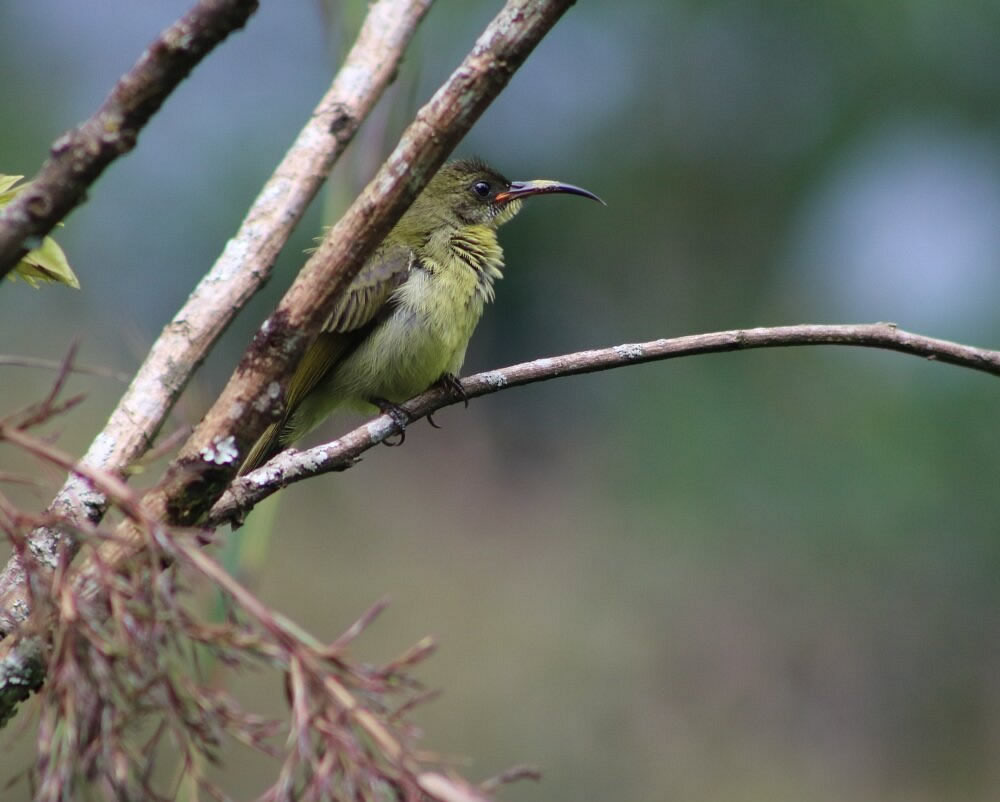 Bird watching tours start at 7am at Kanyanchu; you are advised to book in advance. Rare species include the Papyrus Gonolek, White-winged Warbler, White-collared Olive back and Papyrus Canary.
Bird watching tours start at 7am at Kanyanchu; you are advised to book in advance. Rare species include the Papyrus Gonolek, White-winged Warbler, White-collared Olive back and Papyrus Canary.
Nature walks in Kibale
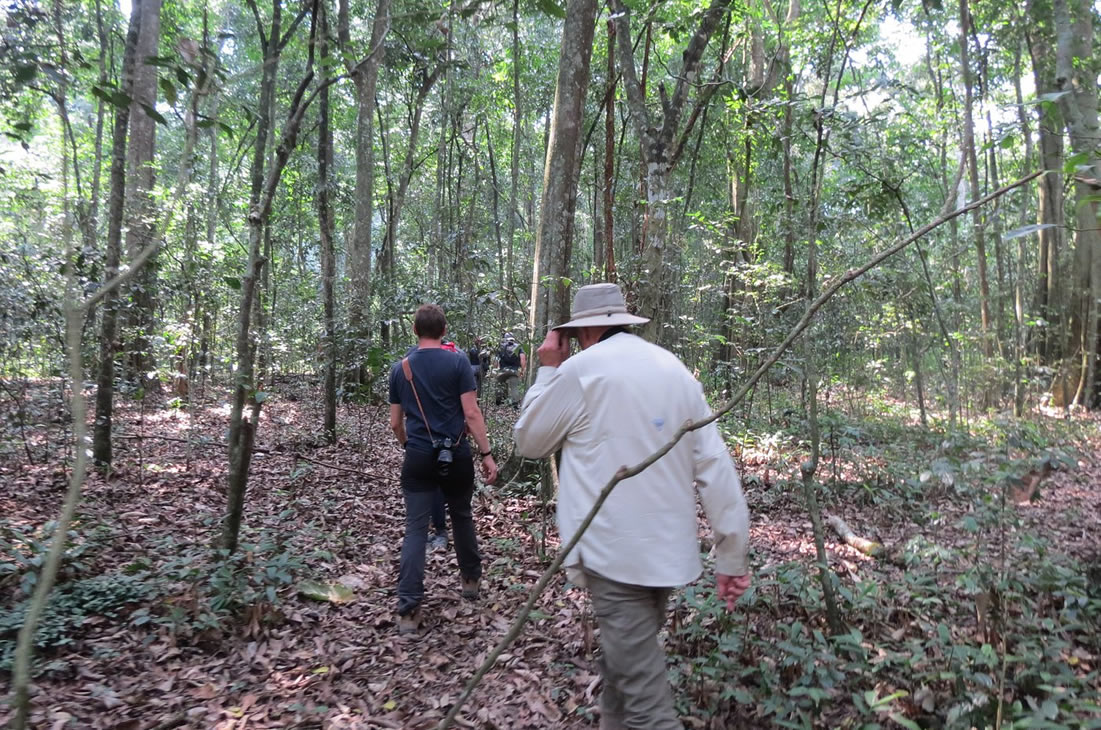
When chimpanzees and other forest residents rest up at dusk, a nighttime shift of rarely seen creatures becomes active. Night walks though the darkened forest use powerful torches to seek nocturnal creatures such as the pottos, bush baby, nightjar, cricket and tree hyrax, with its chilling shriek, as well as the occasional civet or serval cat. Night walks leave the camp at 7.30pm and last between one and a half and two hours.
Guided Primate Walks
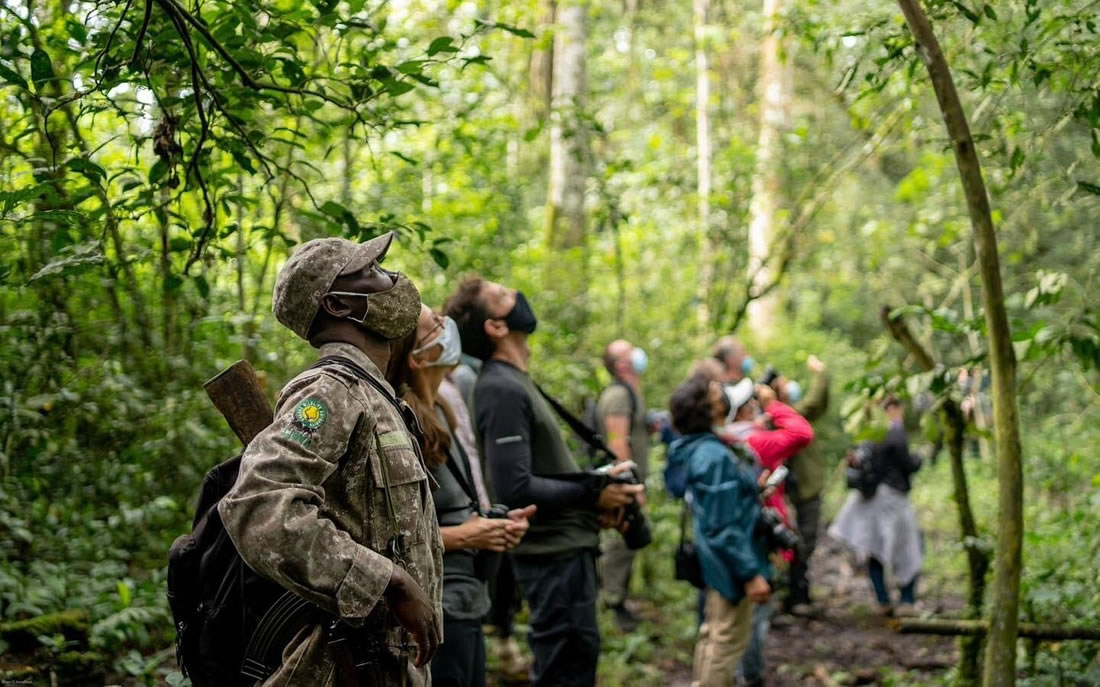
lasting 2-4 hours leave camp daily at 8am & 3pm. This is Kanyanchu’s most popular walk highlighting the diversity of the primates within the Park. The guides have a wealth of knowledge on all aspects of forest ecology including birds, butterflies and medicinal plants. Chances favour viewing the chimpanzees. This is restricted to 3 groups of 6 visitors in the morning, and again in the afternoon.
Guided Night Walks
from 7:3Opm-9pm.A chance to view the nightlife of KNP, including bushbabies, pottos, civets, genets, owls and bats. With a new powerful spotlight impressive viewing is offered.
Guided Forest Hike
Walks start from 8pm-2pm. This seasonal 12 km hike is restricted to the dry season. It highlights the diverse habitats of KNP including tropical forest, riverine forest, swamp and grassland. Birds and primates are viewed throughout the walk which finishes at an elephant wallow. Bring a packed lunch
Research
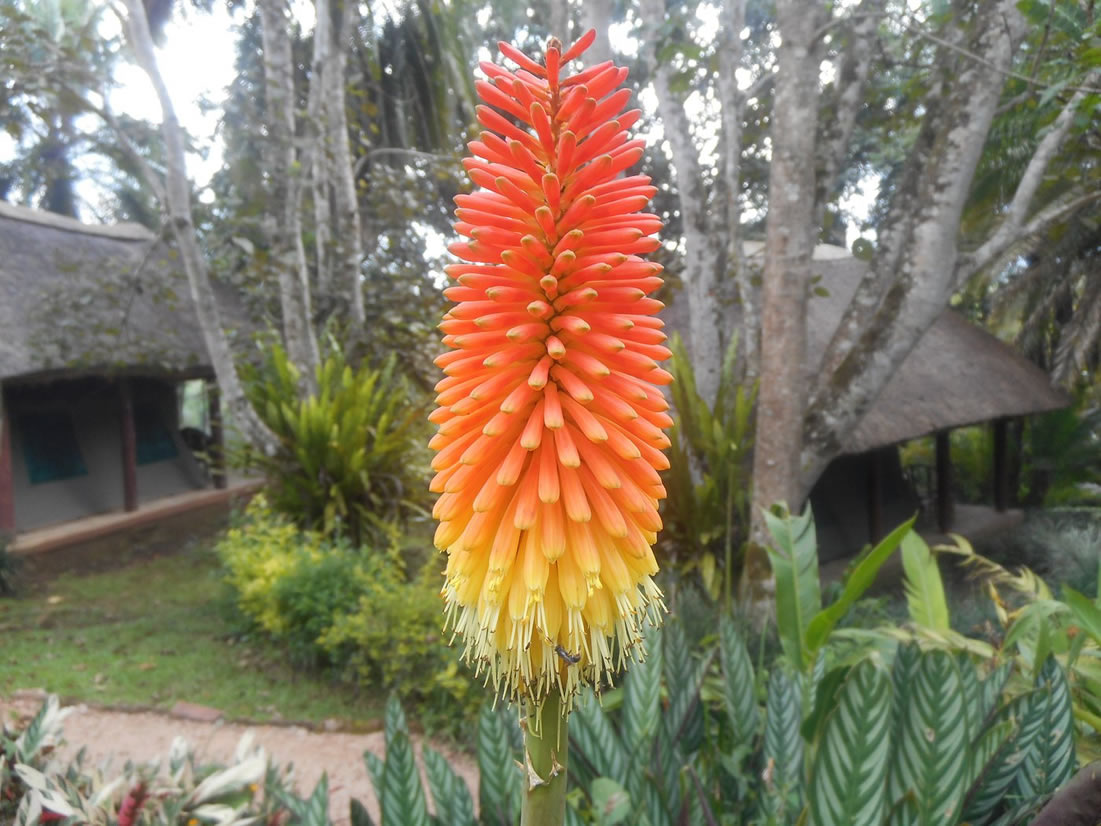 Kibale forest is an ideal location for their research activities in areas of Forestry, Botany, Ecology, research about Chimpanzees, Birds among other research disciplines.
Kibale forest is an ideal location for their research activities in areas of Forestry, Botany, Ecology, research about Chimpanzees, Birds among other research disciplines.
Places of Interest Close to Kibale Forest
There are various places of interest that are worthy visiting while visiting the Queen Elizabeth National Park. These include;
Bigodi Wetland
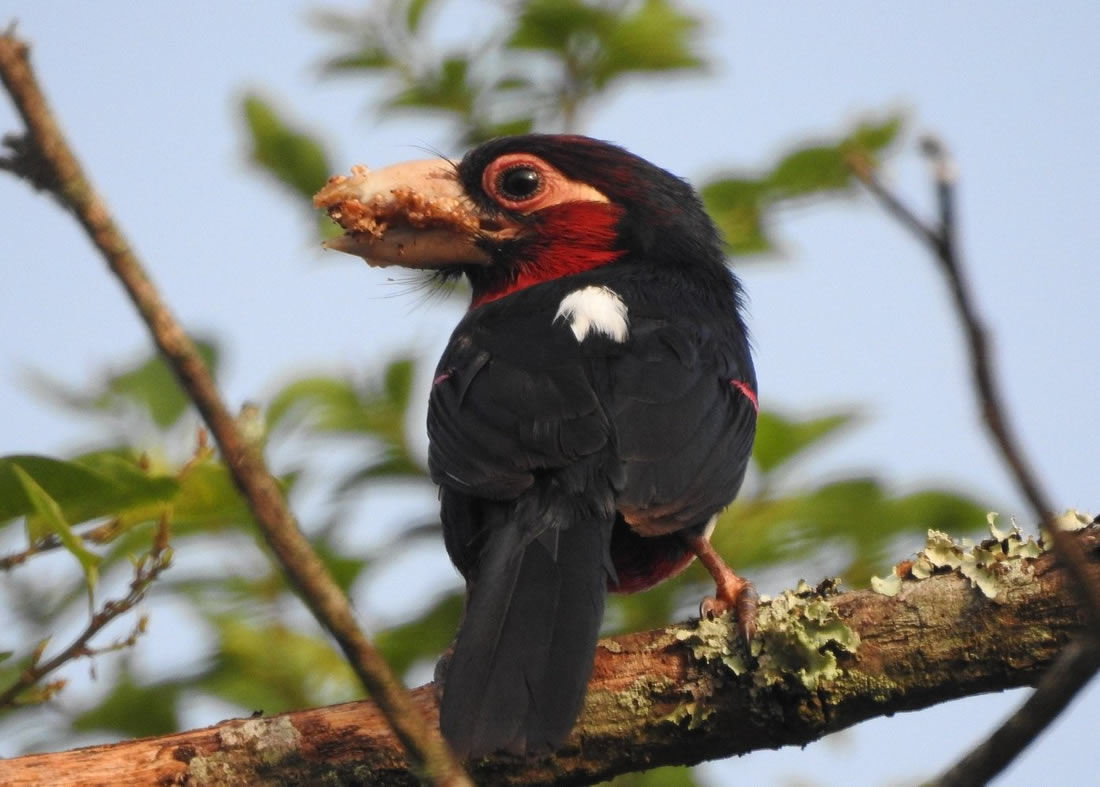 Bigodi Wetland Sanctuary, located just outside the park, is home to 138 bird species which may be seen during guided walks along the boardwalk trail and viewing platforms. These could include the White-spotted Fluff tail, Yellow-spotted Barbet, Hairy-breasted Barbet, Yellow-billed Barbet, Western Nicator, Grey-winged Robin-chat, White-tailed Ant-thrush, Brown-backed Scrub-robin, Black-and-white Shrike-flycatcher, Brown-throated Wattle-eye, Superb Sunbird, Brown-crowned Tchagra, Bocage’s Bush-shrike, Black Bishop, White-breasted Negrofinch and Black-crowned Waxbill among others.
Bigodi Wetland Sanctuary, located just outside the park, is home to 138 bird species which may be seen during guided walks along the boardwalk trail and viewing platforms. These could include the White-spotted Fluff tail, Yellow-spotted Barbet, Hairy-breasted Barbet, Yellow-billed Barbet, Western Nicator, Grey-winged Robin-chat, White-tailed Ant-thrush, Brown-backed Scrub-robin, Black-and-white Shrike-flycatcher, Brown-throated Wattle-eye, Superb Sunbird, Brown-crowned Tchagra, Bocage’s Bush-shrike, Black Bishop, White-breasted Negrofinch and Black-crowned Waxbill among others.
Kanyanchu Tourist Centre
![]() With an open forest and large community of chimpanzee, Kanyanchu offers an enjoyable chimpanzee tracking experience. There is an on-going habituation project of chimpanzees and monkeys run by The Jane Goodall Institute & Uganda Wildlife Authority. All of the guides are actively involved with the Kibale Habituation Project. Visitors are assured that they are supporting a sustainable eco-tourism initiative for effective conservation of the Park.
With an open forest and large community of chimpanzee, Kanyanchu offers an enjoyable chimpanzee tracking experience. There is an on-going habituation project of chimpanzees and monkeys run by The Jane Goodall Institute & Uganda Wildlife Authority. All of the guides are actively involved with the Kibale Habituation Project. Visitors are assured that they are supporting a sustainable eco-tourism initiative for effective conservation of the Park.
The Crater Lakes that surround Fort Portal are another popular destination for visitors. There are many of them, each differing in size and character and several have well developed visitor facilities. These lakes have fishing, swimming, great birding, easy access to Kibale National Park, and a solitary hippo that timeshares between a few of them. The crater lakes are bilharzia-free and perfect places to spend a few inexpensive and idyllic days resting, relaxing, and recovering from the rigors of travel.
Magombe Swamp, is located close to Kanyancu, the tourism center of Kibale National Park, and is developed for tourism by a community group. A trail and boardwalk take you around and through the swamp where birding is good and several species of monkeys are apt to be seen, as well as the interaction between human needs and the needs and benefits of conservation.
Fortportal Town
This is the tourism city of Uganda. In Fort Portal itself are the old and new palaces and parliament of the Toro Kingdom, and the resting places of three of the kings (Karaambi Tombs) is only a short ride away. Bicycle tours are a popular way of seeing some of the sights and views close to town (including the Crater Lakes and Amabere Caves).
Plan Your Safari
The park lies close to the tranquil Ndali-Kasenda crater area and within half a day’s drive of the Queen Elizabeth National Park, Ruwenzori Mountains National Park and Semuliki National Park, as well as the Toro-Semuliki Wildlife Reserve. Many tourists who visit Kibale Forest often combine it with Bwindi Impenetrable National Park, Murchison Falls Game Park, Amabeere ga Nyinamwiru, and more.
Where is Kibale Forest National Park?
The park is located near the foothills of the Mountains of the Moon in western Uganda. It is the most accessible of all Uganda’s major tropical rainforests. The Kibale National Park (795 km2) is located in western Uganda (0 13′ – 0 41′ N and 30 19′ – 30 32′ E) near the foothills of the Ruwenzori Mountains.
Getting to Kibale National Park in Uganda
The park lies 320km along a mostly surfaced direct road from Kampala and 35km south of Fort Portal. A four-wheel drive vehicle is recommended, especially during the rainy season. To ease movement, tourists who wish to visit Kibale National Park should hire a car from a reputable company such as Car Rental Uganda.
From Kasese it is only one hour driving journey. From Fort Portal, the park lies only 35 Km and can be accessed via a dirt road that connects to Kanyanchu Tourist Centre. For those who prefer to travel by air, a private charter flight to Kasese airstrip can be arranged and combined with a transfer to Kibale by road (1 hour Drive)
From Kampala, there are many routes leading to Kibale National Park in Western Uganda. From Kampala, you can drive via Mityana-Mubende-Fort Portal tourism city to Kibale about 6 hours’ drive journey. From Fort Portal to Kibale, it is about half an hour’s drive.
From Queen Elizabeth National Park, it is easier connecting up to Kibale about 3-4 hours’ drive and from Murchison, you can spend 7-8 hours’ drive pass through Hoima Oil city to Fort Portal.
Chimpanzee Permits
Chimpanzee permits are essential when it comes to chimpanzee trekking or chimpanzee habituation experience. Each chimpanzee trekking permit costs USD200 and chimpanzee habituation permits are available for booking at USD250 per person.
When is the Best time to Visit Chimpanzees of Kibale?
Kibale National Park is open to visitors on chimpanzee safari at any time of the year. It is one destination that enjoys favorable weather conditions all year-round but chimpanzee trekking is best done during the dry season. This is either during the extended dry season or short dry season. The extended or long dry season runs from June to September and short drier months include December, January & February.
What to Carry on a Safari to Kibale
The essential items not to miss on any packing list for chimpanzee trekking in Kibale National Park include waterproof hiking boots or shoes, daypack, socks, long sleeved shirts, camera, insect repellent, a bottled drinking water, rain jacket, etc.
Where to Stay in Kibale National Park
There are a number of hotels and safari lodges where to stay during your holiday to Kibale Forest National Park. You can choose to stay in hotels in Fort Portal or within lodges close to the Kibale Forest.
Camping
Camping facilities are available including private camp site areas, a general campsite area and private tented accommodation. Bandas (under construction near completion) with double beds and shower will also be available.
Another good spot for campers and backpackers is Rwengo Lakeside Tourism Camp.
All campsites provide a cooking area and fuel wood. Bring food & cooking utensils or book meals through the canteen. Nights can be cool.
There are several campsites where you can stay with a camper van or rooftop tent vehicle. Here you must bring your own tent and bedding.
At all sites, you must bring your own food and utensils. Fuel can be provided for cooking.
Budget Accommodation
The Ruwenzori View Guesthouse is situated in beautiful and quiet Surroundings. All rooms have hot and cold running water, shower and toilet. In this family-run establishment the ambience is friendly and the food is extraordinarily good. Another alternative is the Crater Valley Kibale Resort Beach Lodge just on the border of the Park, or Kanyanchu Tourist Camp just 35 km from Fort Portal town. It is elevated to provide beautiful views of the snow-capped Rwenzori Mountains.
At the nearby villages of Bigodi and Nkingo, there are simple lodges, and meals are available. Inside the park, camping facilities are available.
Midrange Lodges
There are several midrange lodges for your stay near Kibale Forest. Bedding is provided.
Other midrange lodges in the park include Turaco Tree Tops, Isunga Lodge, Rwenzori View Guesthouse, Chimpanzee Guest House and others.
Luxury Lodging
At Ndali Lodge, each of the cottages face the Mountains of the Moon. On a clear morning, the snow on the peaks is clearly visible. All cottages have private facilities. The lodge sits near a delightful crater lake. The lodge provides a friendly welcome and an interesting stay.
The Crater Safari Lodge is another deluxe lodge that offers accommodation to travelers.
Other luxury lodges include Kibale Primates Lodge, Papaya Lake Lodge, Kyaninga Lodge and more.
Latest News and Updates
What is happening in Kibale National Park? Read the latest news, updates, tips and advice to help you plan a perfect safari.
What are the Chances of Seeing Chimpanzees in Uganda?
Strange Facts About Chimpanzees
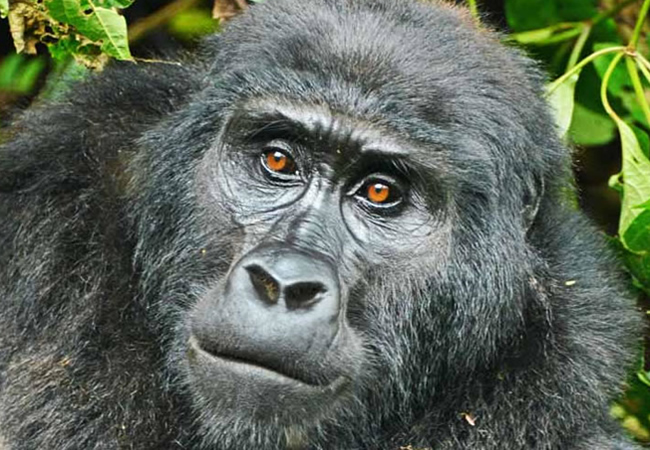
The Great Apes of Africa
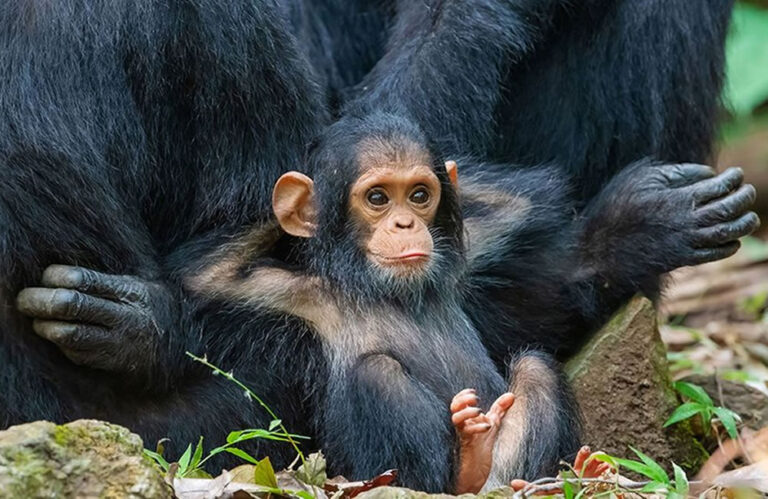
12 Facts You Didn’t Know About Chimpanzees
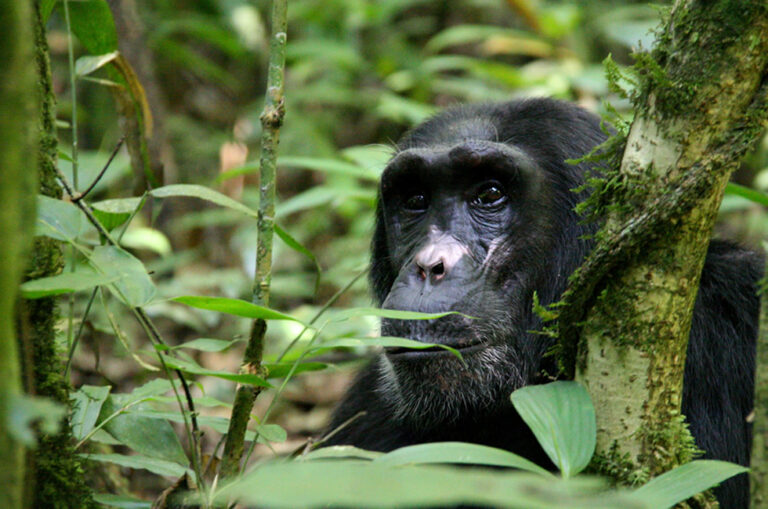
Chimpanzee Tracking vs Chimpanzee Habituation

